SpaceX Dragon capsule docked today. What exactly happens in docking?
Docking procedure was slightly delayed by a technical hitch which was soon fixed by NASA

Docking refers to the process of spacecrafts connecting in space. It is a critical part of getting astronauts and supplies to and from the International Space Station (ISS).
The ISS is a large modular space station in orbit around Earth. It is about the size of a big football field and orbits at an altitude of about 400 kilometers above the Earth's surface.
ISS travels at a speed of about 28,000 kilometers per hour, completing one orbit around the Earth every 90 minutes.
Following correct trajectory
To dock with the ISS, SpaceX Dragon capsule (named Endeavour) approached it slowly and carefully. The spacecraft was monitored by the ISS crew and ground control to ensure that it is on course and following the correct trajectory.
The SpaceX Dragon capsule docked following a 24-hour journey to deliver four astronauts to their new home for six months. After a short wait 20 meters from ISS to fix a troubleshooting issue, the Dragon capsule docked autonomously to the space-facing port of the station.
The docking sequence finished at about 10.54 a.m. (Updated)
Docking is a complex, delicate process. The Endeavour capsule must be aligned correctly with the ISS docking port, which is an opening on the side of the ISS where the spacecraft will attach.
Once the spacecraft is in position, it will use a docking mechanism to connect with the space station. This mechanism is called the International Docking Adapter (IDA).
Also Read: Photos: Tracing the journey of UAE's Sultan Al Neyadi from launchpad to International Space Station
Also Read: SpaceX launch: As Sultan Al Neyadi blasts off to the ISS, why the UAE space programme matters
Precision and attention
The docking process requires precision and attention to detail. The spacecraft will use thrusters to move closer to the ISS and must align itself with the IDA very precisely.
Once it is in position, SpaceX Dragon will use its docking mechanism to latch onto the IDA and create an airtight seal. The spacecraft will then be secured to the ISS using a series of hooks and latches.
All the while, the astronauts will approach the ISS after slow, careful maneuvers, using the Endeavour's advanced navigation systems to align with the IDA.
An airtight seal
Once it is in position, the spacecraft's docking mechanism will latch onto the IDA and create an airtight seal.
The docking process can take a while, during which time the crew aboard the spacecraft and the ISS will run a series of checks to ensure that everything is working correctly.
Once the Endeavour recieves a green light, the Emirati astronaut Sultan Al Neyadi along with the crew will clamber through the hatch on to the International Space Station.
Sign up for the Daily Briefing
Get the latest news and updates straight to your inbox


